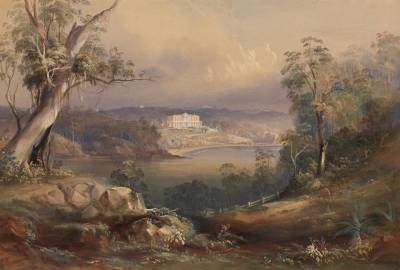This is an old revision of the document!
'Roxburgh Castle' memoir
TLM-P wrote his 'Draft memoirs of a voyage from London to Sydney on the Roxburgh Castle', c.18791) for his daughter Rosa Praed to use in her planned 'sketch of colonial life'. He wrote it, he explained, while suffering from lumbago (lower back pain) which left him unable to do physical work. He was relying on his memory of events over 40 years ago, so this evidence must be treated with caution. As well, as with most memoirs, he highlights the aspect of his youthful self he most admired and wished his daughter to appreciate. The anecdotes he chooses to tell his daughter reinforce the perception of a young man full of high spirits: his proposing the toast to the Catholic reformer Daniel O'Connor in response to an Orangeman's toast; shooting bottles then albatrosses; and defying Captain Cumberland by diving off the Roxburgh Castle to swim, disbelieving warnings of sharks until one was caught by the crew.
TLM-P recalled that there were some 20 to 30 in the first class accommodation (cabin class); 'several' passengers in second class accommodation; and 'about 200 emigrants' jammed into the third class accommodation. They also picked up new passengers when stopped at Cape Town. While he deplored his father's financial recklessness and was aware his mother had scrimped to provide money for him, he takes it for granted that he sailed 'cabin' class. Class divisions were strong and he showed no interest in those who could not afford first class. Despite his disregard, the white population of NSW was so small that he would have encountered them in later life: emigrants like 21-year-old Jane McCormick who, a decade later, had married and, with her husband, ran a major store at Singleton in the Hunter Valley.2)
Among the other cabin passengers TLM-P remembered was the Rev W.B. Clarke and his family (wife Maria Clark and 5 years-old Mordaunt and 3 year old Ellen). Clarke, soon after his arrival in Sydney, was appointed headmaster of The Kings School, but his main claim to fame was as an amateur geologist and for suppressing his discovery of gold deposits.3) When TLM-P first saw Clarke using his geologist hammer to investigate a boulder at Cape Town, he assumed Clarke was drunk or insane - as he wrote, geology was then in its infancy and he had never seen anyone do anything like that. TLM-P shared his cabin with 'an old Portsmouth friend, Dr Chas [Charles] Scott'. The Australian Medical Pioneers Index shows that Dr Scott purchased land at Raymond Terrace in the Hunter Valley in 1840 but that he returned to England by 1842.4) TLM-P and Scott made friends with Charles Hall 'a Cambridge man and a capital fellow', taking down the divider between their and his adjoining cabin.5)
The voyage took a turn for the worse after their Cape Town stop-over: with new passengers and provisions came contaminated food or water. Passengers first came down with dysentery (diarrhea) then around 30 contacted typhoid fever: 'within a few days', 15 died.6) At some point, to cheer the crew, the Captain suggested that TLM-P scramble up the rigging and let the crew try to catch him - which they did, with the escapade having 'the effect the Captain desired … a laugh'. More danger presented when the ship neared Bass Strait, with the Captain confiding he wasn't sure of their position and asking the three friends to 'not take off your clothes tonight, and be ready in case of accident but say nothing to any of the other passengers'. Despite a near miss with a 'great rock', the ship successfully made it into the Strait. The Captain was so relieved that he 'called on hands to splice the mainbrace. This was the first time I had tasted raw spirits'.
Sailing up the coast to Sydney, TLM-P saw the 'blacks' fires burning in several directions'.7) Nearing Sydney, he recalled he was 'in a state of fierce excitement … the time [on board] had passed … on the whole pleasantly. But now an unknown future lay before me … [the only thing] that seemed clear was that I should have to labour for my own living in any way [he could] … in a new country and among total strangers. These thoughts troubled me a little; but youth, energy, the love of adventure and the determination to succeed carried the day.' He though the ship would have gone into quarantine except that two of the passengers were the mother and sister of the Harbour master's wife.8) TLM-P was among those who stayed on the ship overnight, and recalled looking over what we now know as the eastern suburbs. The water was 'smooth, beautiful'; the harbour had trees growing 'down among the rocks to the water's edge'. He could see no houses, writing that 'Vaucluse, Mr Wentworth's place,9) was one of the few houses in the neighbourhood'. His recollection is a reminder that he was not an objective observer, but one who saw with English eyes. He looked for the mansions of the colonial gentry as evidence of civilisation. There were few to see in 1839, as shown in this Conrad Martins painting of Elizabeth Bay and Elizabeth Bay House.10) Nor did he see evidence of the continuing occupation of the Aboriginal survivors - they were to remain 'hidden in plain view'.11)

TLM-P's memoir unfortunately ends with him disembarking, so we have no information about his first impressions of Sydney people or how he found employment.